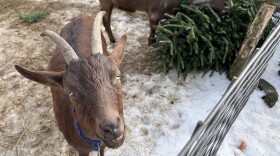Every other Friday on Morning Edition, Outside/In host Sam Evans-Brown tackles a question from a listener.
Suzanne from Concord asks: “I’m trying to find out why ladybugs are in my house in the spring, and did they all live together in my house over the winter? And if they did that, what did they eat? Or do they eat? Do they hibernate? And now they’re dropping dead, I mean out of six ladybugs, there are two alive.”
Note: This eidition of Ask Sam originally aired in March of 2020.
What you are most likely seeing is called (among many other things) the Harlequin Ladybeetle. It gets that name (as well as all its others) because it has a lot of different presentations — many different numbers and arrangements of spots — and it's an invasive species from Asia.
“It’s basically been released as a biological control agent, in multiple places,” says William Fincham, who researches ladybugs with the UK Centre for Ecology and Hydrology, “In the U.S, in multiple places in Europe as well.”
Even though there are like 450 species of North American ladybug, the simple fact that they are in your house in large numbers suggests that the beetles you’re seeing are Harlequins. Most of the native species don’t tend to gravitate toward buildings when the weather starts to get colder.
“It’s thought that with the Harlequin Ladybirds that back in their native range in Asia, they head up mountain sides for the winter months,” explains Helen Roy, a colleague of Fincham’s who I interviewed at the same time. Roy explained that Harlequins often gravitate toward the second floor of buildings, and toward pale surfaces in particular. “And so one of the speculations is that, is it that these are sort of representing the mountains back in their native range. It’s the closest they can get to home I guess.”
Which gets to a finer point, while you may be just noticing lady beetles and other bugs in your house as the spring rolls around, they have been in your house all winter. They head in there in the fall, looking for someplace warm, (which is a trend with critters that you find indoors) and go into a state called diapause. (Which is not the same as hibernation biologically speaking, but you can think of it as the bug version of hibernation.)
As for why are they dropping dead? Well, not eating all winter is tough and some of them just didn’t have enough stores to keep going once they woke back up.
If you’re someone who has lived in New England your whole life and you’ve noticed more ladybugs in your house than when you were a kid, you’re not wrong. They only arrived in the northeast in 1994.
But because the Harlequin is a voracious predator (William Fincham told me they eat about twice as much as one of the UK’s native ladybugs) and also carries a particular fungus on its body that kills off other native lady beetles, it is outcompeting our native ladybugs in dramatic fashion.
But if you’re looking for an overarching point to draw from the story of this ladybug, it’s this: if you’re introducing a non-native species to fight pests, generalists are bad news bears. And Harlequins are definitely generalists. They eat everything. Hell, I’ve even been bitten by one!
And if we’ve learned anything from the very checkered history of biological control, the practice of trying to use non-native species to control pests, it’s that it can work if you use species that are specialized to only eat one very specific pest. But it can be disastrous if you introduce generalists — think of the cane toad in Australia, the mongoose in Hawaii, and, yes, the Harlequin ladybird in the US.
Now, some good news. If you’re looking for something to do with your children during the weeks and weeks of being stuck in your house that we’re all anticipating this spring, consider taking pictures of ladybugs!
Cornell University is soliciting your photographs through something called the Lost Ladybug Project. Teach your kids to identify our increasingly rare native two-spotted and nine-spotted ladybugs and tell them their task for the day is to document every stray beetle that has made its way into your house.
That should give you at least an hour to get work done remotely!
Sam Evans-Brown, is host of NHPR’s Outside/In which you can subscribe to where-ever you get your podcasts. If you’d like to submit a question you can record it as a voice memo on your smartphone and send it to oustidein@nhpr.org, OR call the hotline, 1-844-GO-OTTER, OR submit it here.








